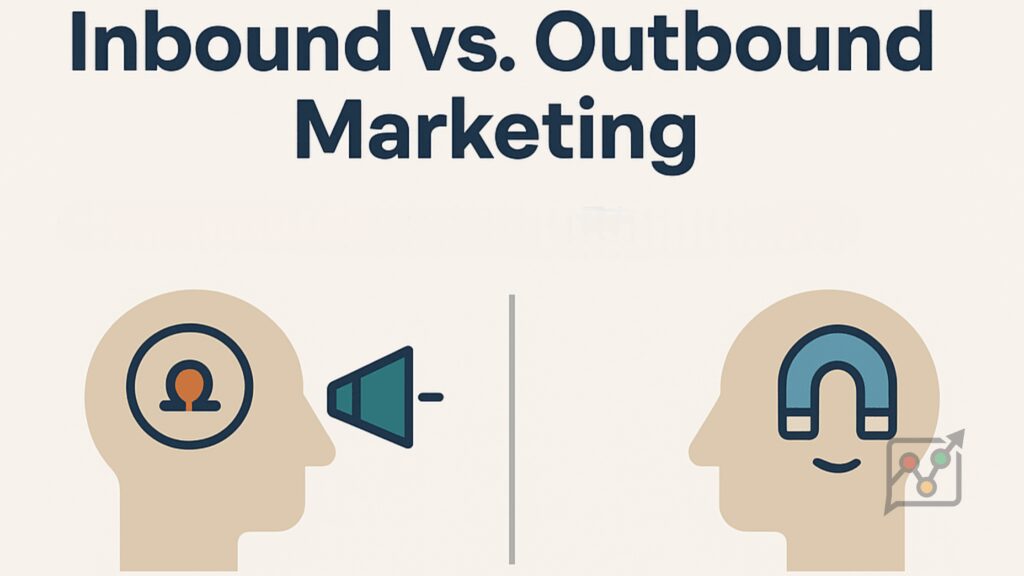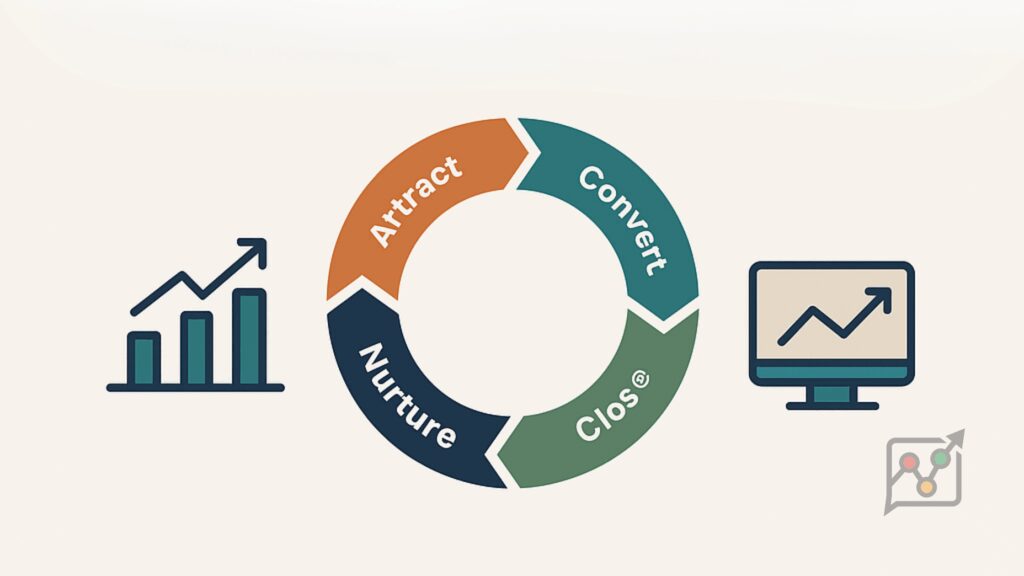Our business case for why we focus on inbound vs. outbound marketing strategies to generate leads for our clients
Every business owner knows the importance of leads. Leads are potential customers who have shown an interest in your product or service and have provided contact information that you can use to follow up with more information. But have you ever wondered how best to generate more leads for your business when they aren’t already coming in via word-of-mouth referrals?
Enter the marketing world – promoting your product or service to the people you want to work with. And in this world, there are two big categories – inbound and outbound marketing. At Improve & Grow, we focus on lead generation using inbound marketing approaches. This article will explain why.
Inbound vs. Outbound Marketing: A Simple Breakdown

First, let’s get on the same page with some quick definitions.
What Is Outbound Marketing?
Outbound marketing means pushing your message out to a target audience, often without their prior interest. Examples include TV commercials, radio ads, print campaigns, cold calls, cold emails, or unsolicited LinkedIn messages. While it can be targeted, it’s often interruptive and based on one-way communication.
It’s important to remember that outbound marketing isn’t about casting a wide net; it’s about targeting the right audience with the right message. Therefore, the success of outbound marketing strategies heavily depends on research and understanding your target audience.
What Is Inbound Marketing?
Inbound marketing is about attracting your ideal clients by creating content and experiences that answer their needs. Common inbound tactics include search engine optimization (SEO), blogging, email marketing, webinars, and social media content. It builds trust over time and invites prospects to engage on their terms.
The key advantage of inbound lead generation is that it builds a long-term relationship with customers. By providing valuable content, you’re establishing your business as a trustworthy source of information. However, it’s important to note that inbound marketing often requires a significant time investment and the results may not be immediate.
Comparison Table
Here’s a table contrasting the key characteristics of each:
| Outbound Marketing | Inbound Marketing |
| Goal is to persuade | Goal is to educate |
| Interruptive | Permission-based |
| Attention is bought | Attention is earned |
| Linear growth | Exponential growth |
| Company-focused | Customer-focused |
| One-way communication | Two-way communication |
Pros and Cons of Inbound and Outbound Marketing Strategies
Inbound and outbound marketing both have strengths and limitations. Understanding the trade-offs helps businesses make informed decisions based on goals, budget, timeline, and customer preferences.
Outbound Marketing
Pros:
- Immediate results
Outbound strategies, such as paid advertising or cold outreach, are designed for quick visibility. They’re ideal when you need to create awareness fast or drive leads within a short time frame. - Easy tracking
Many outbound tactics provide clear, short-term performance metrics—like impressions, click-through rates, and conversion rates—making it easier to measure ROI and optimize quickly. - Direct communication with potential customers
Outbound puts your brand in front of people who may not have found you otherwise. This can be especially useful for new businesses or new product launches.
Cons:
- Risk of being intrusive or unwanted
Cold calls, mass emails, or unsolicited ads can interrupt and annoy recipients—potentially damaging your brand’s reputation or trustworthiness. - High cost potential
Outbound campaigns often require significant investment in media space, ad creative, and campaign management. Paid ads, especially in competitive industries, can be expensive to sustain. - Lower response rates
Because outbound messaging targets people who haven’t expressed interest yet, the conversion rates tend to be lower compared to leads that come in through inbound methods.
Inbound Marketing
Pros:
- Builds long-term relationships and trust
Inbound focuses on attracting customers through helpful, relevant content. By educating rather than selling, it positions your brand as a valuable resource, which builds credibility and nurtures trust over time. - Cost-effective over the long run
While inbound requires consistent effort, its assets (blog posts, optimized landing pages, downloadable guides) continue to generate leads well after they’re published, reducing cost per lead over time. - Aligns with how modern buyers behave
Today’s customers prefer to self-educate and research before speaking with sales. Inbound meets them where they are—through search, social, and content—when they’re ready to engage.
Cons:
- Takes time to produce results
Inbound lead generation is a long-term strategy. It may take months to build traffic and momentum, especially if you’re starting from scratch or in a competitive space. - Requires ongoing investment in content and optimization
To keep attracting and converting leads, you need to regularly update content, track performance, and adapt to algorithm changes or audience preferences. It’s not a one-time campaign—it’s an ongoing process.
A Comparison of the Cost, Effort, and Expertise Required for Outbound and Inbound Lead Generation Techniques
| Outbound Marketing | Inbound Marketing | |
| Cost | Outbound marketing is more expensive due to paid advertising channels like TV, radio, and print media. Costs vary based on media, campaign scale, and reach. | Inbound marketing is often less expensive, focusing on valuable content tailored to customers. Costs include content creation, SEO, website design, and maintenance. |
| Effort | Outbound marketing requires significant effort in planning, executing campaigns, creating materials, and managing ad space. Ongoing tracking and adjusting strategies are also needed. | Inbound marketing demands time and energy in creating high-quality content, optimizing for search engines, managing social media and email campaigns, and continuous customer engagement. |
| Expertise | Outbound marketing is more expensive due to paid advertising channels like TV, radio, and print media. Costs vary based on media, campaign scale and reach. | Inbound marketing expertise involves content creation, SEO, social media marketing, email marketing, data analysis, understanding customer behavior, and staying updated on digital trends. |
When comparing outbound and inbound marketing, various factors come into play. While outbound marketing often delivers faster results and allows for easy success tracking, it can also come with higher costs and lower response rates. On the other hand, inbound marketing builds long-term relationships and trust with customers but requires a significant time investment and the results are often not immediate.
The choice between outbound and inbound marketing doesn’t have to be binary. A balanced approach that combines both strategies can often be the most effective. For example, a startup could use inbound marketing tactics to build brand awareness and engage with audiences while also using targeted outbound marketing to reach potential customers more directly and quickly.
Ultimately, the decision should be guided by the startup’s unique circumstances, including its goals, resources, and target market. It’s also important to continually evaluate and adjust the marketing strategy based on performance data and changing market conditions.
Why Did Improve & Grow Choose to Focus on Inbound Marketing?
As both inbound and outbound marketing approaches have merit, you might ask why we have chosen to focus exclusively on inbound lead generation strategies to generate leads for our clients.
The fundamental reason to choose inbound marketing is its customer-centric approach. It focuses on providing value to the customers rather than simply promoting the product or service. This strategy helps build relationships with potential customers, gain their trust, and eventually turn them into customers out of the need and desire for your solution.
1. Better Quality Leads
Because inbound lead generation involves attracting potential clients through content that is relevant and valuable to them, the leads you generate are likely to be of higher quality. They have demonstrated interest in your business by engaging with your content, which means they are already partially qualified as potential clients. This results in a more effective and efficient sales process. A recent study showed that inbound leads were 8X more likely to result in sales than outbound marketing leads.
2. Cost-Effectiveness
Inbound lead generation strategies, such as content marketing and search engine optimization (SEO), are often more cost-effective than traditional outbound marketing methods. A recent study found that inbound lead generation strategies are 61% more cost-effective than outbound marketing. Instead of spending large amounts of money on advertising to reach a wide audience, you can invest in creating quality content that attracts potential clients to you.
3. Greater Client Trust and Credibility
Inbound lead generation relies on providing value to potential clients through informative and helpful content. This attracts potential clients and helps establish your business as an expert in your field. Over time, this can increase trust and credibility, making potential clients more likely to choose your business when they need professional services.
4. Adaptability to Changing Preferences
Inbound lead generation aligns well with the evolving preferences of potential clients. In the wake of the global pandemic, many decision-makers prefer remote human interactions or digital self-service over face-to-face meetings3. Inbound lead generation can accommodate these preferences, allowing businesses to reach potential clients where they are comfortable and open to engaging.
Inbound Marketing Lead Generation Success Stories:
While studies like the ones referenced above provide important reference points, the actual results our agency’s clients have and are seeing is a more compelling reason we stick to inbound marketing.
Here are just a few examples:
WCI Data Solutions, a data analytics consulting company, increased its volume of qualified sales leads by over 300% and saw a 2X increase in their close rate. You can read the full case study by clicking here.
Jones Square, an outsourced accounting firm, experienced a 77% improvement in the volume of web leads.
adventureTURF, a commercial playground surface installer, experienced a 96% increase in project quote requests.
BR Williams, a trucking and logistics company, saw a 56% increase in prospects requesting a quote for services.
Pathway Financial Group, a financial services company, saw a 50% increase in website leads.
Hanselman Landscape & Gardens saw a 43% increase in website leads
Record Eraser, a firm providing pardon and expungement services, experienced an 87% increase in leads from their website through their inbound lead generation strategy.
So, How Does Inbound Marketing Work?

Inbound marketing uses a combination of tactics designed to attract, engage, and convert qualified leads. At Improve & Grow, we apply these strategies through a structured inbound lead generation system, built to support consistent growth.
1. Content Marketing
We help businesses create and optimize high-value content such as blog posts, eBooks, videos, and guides. This content is designed to address your audience’s questions, solve problems, and guide them through their buying journey.
2. Search Engine Optimization (SEO)
Improve & Grow provides comprehensive SEO services, including on-page optimization, local SEO, technical improvements, and keyword targeting. The goal is to improve your visibility in search engines so your ideal prospects find you when they are actively looking.
3. Paid Advertising and Social Promotion
We manage targeted paid search (PPC) campaigns and promote content through platforms like Google Ads, Facebook, Instagram, and LinkedIn. This helps increase visibility, drive traffic to key landing pages, and attract people actively seeking your services.
4. Website Development and Conversion Optimization
Your website services should work as a lead generation tool. We build and maintain websites that are optimized for user experience, speed, mobile responsiveness, and conversion performance. Every visitor should have a clear path to engage or inquire.
5. Email Marketing and Lead Nurturing
Once someone downloads a guide or fills out a contact form, we help you keep the conversation going. Using email marketing and marketing automation tools integrated with your custom CRM, you can personalize follow-up sequences that nurture leads over time. This approach allows your team to track interactions, score leads, and engage at the right moment, which improves responsiveness and increases conversion rates.
6. Analytics and Continuous Improvement
Every marketing strategy we implement is tracked, measured, and refined based on performance data. Improve & Grow emphasizes data-driven decisions, using web analytics to understand what’s working and to adjust campaigns for better results over time.
How To Get Started with Inbound Marketing?
The last thing you want to do with marketing is jump in and hope for the best. Too often, companies rely on a “try anything” approach, hoping one tactic will stick. We call this “random acts of marketing.” But just like any other major investment, marketing requires careful research, thoughtful planning, and close monitoring to make sure it’s delivering results before scaling up.
To succeed, it’s essential to begin with a strategy that aligns with your financial goals, reflects your brand values, and connects with your ideal prospects to drive real results. We specialize in helping clients create effective, results-driven marketing strategies. Let’s start with a brief 15-minute introductory call to discuss your goals and see how we can help you develop a strategy that delivers consistent growth.
Ready to get started? Let’s chat.
Inbound Lead Generation FAQs
Is inbound marketing expensive?
Any form of marketing will be an investment, but inbound marketing can be very cost-effective compared to outbound marketing, as it focuses on creating quality content and leveraging online platforms, which are often less expensive than traditional advertising channels. A recent study indicated that the cost for leads generated by inbound marketing was 61% more cost-effective than leads generated from outbound marketing. Vist our pricing page for specific guidance and sample budgets for inbound marketing.
How long does it take to see results from inbound marketing?
Getting results from inbound marketing is not an overnight process. Inbound marketing requires consistent effort and can take several months to start showing results. However, there are ways to accelerate results using targeting advertising approaches such as paid search ads.
Can I do inbound marketing myself?
Absolutely! Everything we do here at Improve & Grow was learned through research and practice. That said, getting consistent results takes time and trial and error. Many businesses prefer to hire an inbound marketing agency like Improve & Grow to speed up their learning and get results faster.
Do I need to stop outbound marketing if I start inbound marketing?
Not necessarily. Many businesses successfully use a mix of both inbound and outbound marketing.
What kind of businesses can benefit from inbound marketing?
Any business with an online presence can benefit from inbound marketing. Whether you’re a local roofer, a Christian retreat center, or local attractions, inbound marketing can generate leads and drive growth.
What are the situations where inbound marketing is the better approach?
Inbound marketing, which focuses on attracting customers through relevant and helpful content, can be an effective strategy in several situations. Here are a few scenarios where inbound marketing might be a more suitable choice:
Limited Budget
Inbound marketing often requires less upfront investment than outbound marketing. For small businesses, startups, or companies with a limited marketing budget, inbound marketing can be a cost-effective way to generate leads and build brand awareness. Tactics such as content marketing, search engine optimization, and social media engagement can provide a high return on investment over time.
Long Sales Cycle
For businesses with a longer sales cycle or a complex product offering, inbound marketing allows for the time and space to educate potential customers. By providing valuable content that helps customers understand their problems and the proposed solution, businesses can build trust and nurture leads until they are ready to purchase.
Desire to Build Brand Authority
Inbound marketing, particularly content marketing, and SEO can help businesses establish themselves as thought leaders. By sharing expert advice and insights, businesses can build a reputation for authority and trustworthiness, attracting more organic traffic and improving conversion rates.
Highly Engaged Target Audience
If a business’s target audience is actively seeking information or solutions in the industry, inbound marketing can effectively capture this existing interest. Businesses can attract and convert these engaged prospects by offering valuable content that meets the audience’s needs.
Focus on Customer Retention
Inbound marketing is not only about attracting new customers but also about nurturing existing ones. By continually providing value to existing customers through informative and engaging content, businesses can enhance customer loyalty and encourage repeat purchases.
Are there situations where outbound marketing would be the better choice?
Outbound marketing might be the most effective choice in the following situations:
Product Launches or Brand Awareness Campaigns: Outbound marketing can be particularly effective when launching a new product or service or building awareness around a brand, especially when the product, service, or brand is not yet well-known. Outbound marketing allows companies to reach out to potential customers directly and present their offerings.
Targeting a Hyper-Specific Audience: When a company has a specific target audience, outbound marketing allows them to reach out to these individuals directly. For example, direct mail can be sent to specific neighborhoods, or ads can be placed in industry-specific magazines or websites.
Time-Sensitive Offers or Events: Outbound marketing can help get the message across quickly and efficiently if there is a time-sensitive offer or event. For example, a holiday sale or an upcoming webinar can be promoted via email blasts or social media ads.
High-Value B2B Sales: In B2B marketing, especially for high-ticket items or services, outbound strategies like cold calling or direct emails can often be effective. These strategies allow for personalized, direct communication with decision-makers.




